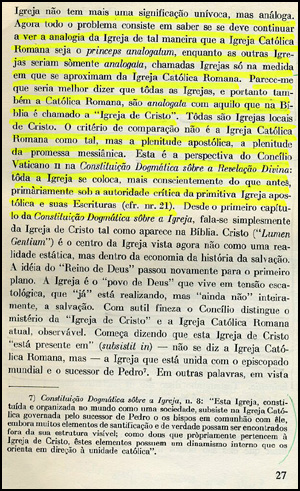A recent document by the Congregation for the Doctrine of the Faith spotlighted the controversy over the 'Church of Christ' as taught by the Council, and its relation with the Catholic Church. To help our readers understand the problem, we offer them an extremelly lucid explanation by Fr. Edward Schillebeeckx on what the new conciliar concept of 'Church of Christ' actually means.
At Vatican II Fr. Schillebeeckx was a perito and the official consultant of the Dutch Episcopate. In 1965 he founded the international magazine Concilium which gathered together the most important theologians who worked on Vatican II. Schillebeeckx is considered one of the most influential Catholic thinkers of his day.
At right, the cover of Five Question that Challenge Today's Church, below right, photocopies from the original Portuguese; below left, our translation of the highlighted text.
By admitting that the other Christian communities are also Church, the Council made a judgment on the incapacity of the Catholic Church herself to realize the plenitude and unity desired by Christ. It is difficult to say that the Catholic Church is still one, the One Catholic Apostolic Church, when one admits that others are equally one, catholic and apostolic, although to a lesser degree.
While maintaining the conviction that the Church of Christ ... is essential for salvation, the Roman Catholic Church officially abandoned her monopoly over the Christian religion at Vatican Council II. In the conciliar documents, belonging to the Church no longer has an univocal meaning, but an analogous one. Now, the whole problem is to know whether one should continue to view this analogy as the Roman Catholic Church being the princeps analogatum [the criterion of comparison], while the other Churches are mere analogata [analogies], called churches only to the degree that they draw near the Roman Catholic Church.
To me it would seem better to say that all the churches, and therefore also the Roman Catholic one, are analogata [analogies] in relation to that which in the Bible is called the "Church of Christ." They are all local churches of Christ. The criterion for comparison is no longer the Roman Catholic Church as such, but the apostolic plenitude, the plenitude of the messianic promise.
This is the perspective of Vatican Council II. In the Dogmatic Constitution on Divine Revelation [Dei Verbum], the whole Church is placed, more consciously than before, primarily under the critical authority of the primitive apostolic Church and its Scriptures (DV 21).
(Edward Schillebeeckx, Introduction to Cinco Problemas que Desafiam a Igreja Hoje, São Paulo: Herder, 1970, pp. 26-27)
|



|
